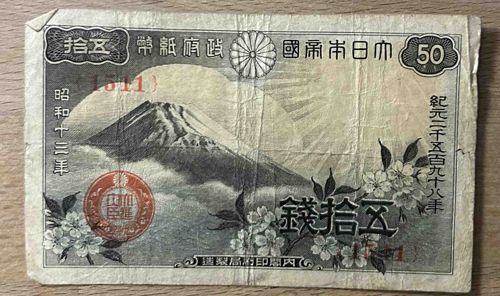
Japanese 50 Sen Banknote (Showa 13)
This is a vintage Japanese 50 Sen banknote, likely issued during the Showa era, specifically 'Showa 13' (1938), as indicated by the characters on the left side ('昭和十三年'). The note features a prominent depiction of Mount Fuji, partially obscured by clouds or mist, set against a background of radiating lines resembling sun rays. The foreground is adorned with delicate cherry blossoms (sakura) with dark leaves, wrapping around the lower corners of the central image. The color palette primarily consists of muted greens, grays, and browns for the central landscape, with the cherry blossoms in white and light pink, and accent colors of red for seals and serial numbers. The overall dimensions appear to be consistent with standard period banknotes, though exact measurements are not quantifiable from the image. The note exhibits significant wear, characterized by numerous creases and folds throughout the paper, suggesting extensive circulation. There are several vertical and horizontal fold lines, some quite pronounced. The paper itself shows discoloration and age-related toning. A faint red overprint, possibly a serial number ('1511') or a control mark, is visible over the Mount Fuji illustration. A red circular seal or stamp is present on the lower-left side, partially overlapping the cherry blossoms, containing illegible Japanese characters. The denomination '50' is clearly visible in the upper right corner within an ornate cartouche, and '拾銭' (ju-sen, 10 sen) is also present, likely indicating the value in Japanese characters. The 'Raised imperial russia Stamp' context provided does not directly align with the visual evidence of a Japanese banknote; this note clearly features Japanese script and cultural imagery. The craftsmanship appears to be typical for governmental currency of the period, employing detailed engraving for the illustrations and clear typography for the text. The paper seems to be of standard banknote quality, designed for durability but clearly showing the effects of time and use.
AI-Generated Appraisal Disclaimer
Estimated Value
$5 - $15
Basic Information
Category
Banknote
Appraised On
November 12, 2025
Estimated Value
$5 - $15
Additional Details Provided By Owner
User Provided Information
Raised imperial russia Stamp
Item Description
This is a vintage Japanese 50 Sen banknote, likely issued during the Showa era, specifically 'Showa 13' (1938), as indicated by the characters on the left side ('昭和十三年'). The note features a prominent depiction of Mount Fuji, partially obscured by clouds or mist, set against a background of radiating lines resembling sun rays. The foreground is adorned with delicate cherry blossoms (sakura) with dark leaves, wrapping around the lower corners of the central image. The color palette primarily consists of muted greens, grays, and browns for the central landscape, with the cherry blossoms in white and light pink, and accent colors of red for seals and serial numbers. The overall dimensions appear to be consistent with standard period banknotes, though exact measurements are not quantifiable from the image. The note exhibits significant wear, characterized by numerous creases and folds throughout the paper, suggesting extensive circulation. There are several vertical and horizontal fold lines, some quite pronounced. The paper itself shows discoloration and age-related toning. A faint red overprint, possibly a serial number ('1511') or a control mark, is visible over the Mount Fuji illustration. A red circular seal or stamp is present on the lower-left side, partially overlapping the cherry blossoms, containing illegible Japanese characters. The denomination '50' is clearly visible in the upper right corner within an ornate cartouche, and '拾銭' (ju-sen, 10 sen) is also present, likely indicating the value in Japanese characters. The 'Raised imperial russia Stamp' context provided does not directly align with the visual evidence of a Japanese banknote; this note clearly features Japanese script and cultural imagery. The craftsmanship appears to be typical for governmental currency of the period, employing detailed engraving for the illustrations and clear typography for the text. The paper seems to be of standard banknote quality, designed for durability but clearly showing the effects of time and use.
Get Your Items Appraised
Instant estimates of your treasures with AI-powered instant appraisals